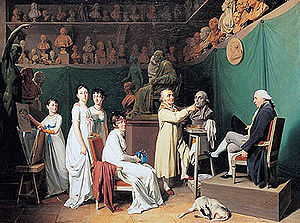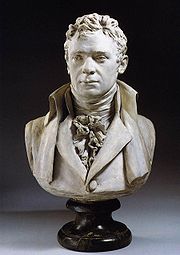
Jean-Antoine Houdon
Encyclopedia


France
The French Republic , The French Republic , The French Republic , (commonly known as France , is a unitary semi-presidential republic in Western Europe with several overseas territories and islands located on other continents and in the Indian, Pacific, and Atlantic oceans. Metropolitan France...
neoclassical sculptor. Houdon is famous for his portrait busts and statues of philosophers, inventors and political figures of the Enlightenment
Age of Enlightenment
The Age of Enlightenment was an elite cultural movement of intellectuals in 18th century Europe that sought to mobilize the power of reason in order to reform society and advance knowledge. It promoted intellectual interchange and opposed intolerance and abuses in church and state...
. Houdon's subjects include Denis Diderot
Denis Diderot
Denis Diderot was a French philosopher, art critic, and writer. He was a prominent person during the Enlightenment and is best known for serving as co-founder and chief editor of and contributor to the Encyclopédie....
(1771), Benjamin Franklin
Benjamin Franklin
Dr. Benjamin Franklin was one of the Founding Fathers of the United States. A noted polymath, Franklin was a leading author, printer, political theorist, politician, postmaster, scientist, musician, inventor, satirist, civic activist, statesman, and diplomat...
(1778-09), Jean-Jacques Rousseau
Jean-Jacques Rousseau
Jean-Jacques Rousseau was a Genevan philosopher, writer, and composer of 18th-century Romanticism. His political philosophy influenced the French Revolution as well as the overall development of modern political, sociological and educational thought.His novel Émile: or, On Education is a treatise...
(1778), Voltaire
Voltaire
François-Marie Arouet , better known by the pen name Voltaire , was a French Enlightenment writer, historian and philosopher famous for his wit and for his advocacy of civil liberties, including freedom of religion, free trade and separation of church and state...
(1781), Molière
Molière
Jean-Baptiste Poquelin, known by his stage name Molière, was a French playwright and actor who is considered to be one of the greatest masters of comedy in Western literature...
(1781), George Washington
George Washington
George Washington was the dominant military and political leader of the new United States of America from 1775 to 1799. He led the American victory over Great Britain in the American Revolutionary War as commander-in-chief of the Continental Army from 1775 to 1783, and presided over the writing of...
(1785–88), Thomas Jefferson
Thomas Jefferson
Thomas Jefferson was the principal author of the United States Declaration of Independence and the Statute of Virginia for Religious Freedom , the third President of the United States and founder of the University of Virginia...
(1789), Louis XVI (1790), Robert Fulton
Robert Fulton
Robert Fulton was an American engineer and inventor who is widely credited with developing the first commercially successful steamboat...
, 1803–04, and Napoléon Bonaparte (1806).
Biography

Prix de Rome
The Prix de Rome was a scholarship for arts students, principally of painting, sculpture, and architecture. It was created, initially for painters and sculptors, in 1663 in France during the reign of Louis XIV. It was an annual bursary for promising artists having proved their talents by...
in 1761 but was not greatly influenced by ancient and Renaissance art in Rome
Rome
Rome is the capital of Italy and the country's largest and most populated city and comune, with over 2.7 million residents in . The city is located in the central-western portion of the Italian Peninsula, on the Tiber River within the Lazio region of Italy.Rome's history spans two and a half...
. His stay in the city is marked by two characteristic and important productions: the superb écorché
Écorché
An écorché is a figure drawn, painted, or sculpted showing the muscles of the body without skin. Renaissance architect and theorist, Leon Battista Alberti recommended that when painters intend to depict a nude, they should first arrange the muscles and bones, then depict the overlying...
http://www.artcyclopedia.com/feature-2003-06-Houdon-Ecorche.html (1767), an anatomical model which has served as a guide to all artists since his day, and the statue of Saint Bruno
Bruno of Cologne
Saint Bruno of Cologne , the founder of the Carthusian Order, personally founded the order's first two communities...
in the church of Santa Maria degli Angeli e dei Martiri
Santa Maria degli Angeli e dei Martiri
The Basilica of St. Mary of the Angels and the Martyrs is a titular basilica church in Rome, built inside the frigidarium of the Baths of Diocletian. The Cardinal priest of the is William Henry Keeler.- The basilica :...
in Rome. After ten years stay in Italy
Italian Peninsula
The Italian Peninsula or Apennine Peninsula is one of the three large peninsulas of Southern Europe , spanning from the Po Valley in the north to the central Mediterranean Sea in the south. The peninsula's shape gives it the nickname Lo Stivale...
, Houdon returned to Paris
Paris
Paris is the capital and largest city in France, situated on the river Seine, in northern France, at the heart of the Île-de-France region...
.
Houdon's portrait sculpture of Washington was the result of a specific invitation by Benjamin Franklin to cross the Atlantic specifically to visit Mount Vernon
Mount Vernon (plantation)
Mount Vernon, located near Alexandria, Virginia, was the plantation home of the first President of the United States, George Washington. The mansion is built of wood in neoclassical Georgian architectural style, and the estate is located on the banks of the Potomac River.Mount Vernon was designated...
, so that Washington could model for him. Washington sat for wet clay life models and a plaster life mask in 1785. These models served for many commissions of Washington, including the standing figure commissioned by the Legislature
Virginia General Assembly
The Virginia General Assembly is the legislative body of the Commonwealth of Virginia, and the oldest legislative body in the Western Hemisphere, established on July 30, 1619. The General Assembly is a bicameral body consisting of a lower house, the Virginia House of Delegates, with 100 members,...
of Virginia
Virginia
The Commonwealth of Virginia , is a U.S. state on the Atlantic Coast of the Southern United States. Virginia is nicknamed the "Old Dominion" and sometimes the "Mother of Presidents" after the eight U.S. presidents born there...
, and located in the Virginia State Capitol
Virginia State Capitol
The Virginia State Capitol is the seat of state government in the Commonwealth of Virginia, located in Richmond, the third capital of Virginia. It houses the oldest legislative body in the United States, the Virginia General Assembly...
in Richmond
Richmond, Virginia
Richmond is the capital of the Commonwealth of Virginia, in the United States. It is an independent city and not part of any county. Richmond is the center of the Richmond Metropolitan Statistical Area and the Greater Richmond area...
. Numerous variations of the Washington bust were produced, portraying him variously as a general in uniform, in the classical manner showing chest musculature, and as Roman Consul Lucius Quinctius Cincinnatus
Cincinnatus
Lucius Quinctius Cincinnatus was an aristocrat and political figure of the Roman Republic, serving as consul in 460 BC and Roman dictator in 458 BC and 439 BC....
clad in a toga. A cast of the latter is located in the Vermont State House
Vermont State House
The Vermont State House, located in Montpelier, is the state capitol of Vermont and the seat of the Vermont General Assembly. The current Greek Revival structure is the third building on the same site to be used as the State House...
.
Houdon's sculptures were used as models for the engravings used on various U.S. Postage stamps of the late 19th and early 20th centuries which depict Washington in profile.
Houdon became a member of the Académie de peinture et de sculpture
Académie de peinture et de sculpture
The Académie royale de peinture et de sculpture , Paris, was founded in 1648, modelled on Italian examples, such as the Accademia di San Luca in Rome. Paris already had the Académie de Saint-Luc, which was a city artist guild like any other Guild of Saint Luke...
in 1771, and a professor
Professor
A professor is a scholarly teacher; the precise meaning of the term varies by country. Literally, professor derives from Latin as a "person who professes" being usually an expert in arts or sciences; a teacher of high rank...
in 1778. Perceived as bourgeois for his connections to the court of Louis XVI, he fell out of favor during the French Revolution
French Revolution
The French Revolution , sometimes distinguished as the 'Great French Revolution' , was a period of radical social and political upheaval in France and Europe. The absolute monarchy that had ruled France for centuries collapsed in three years...
, although he escaped imprisonment. Houdon returned to favor during the French Consulate
French Consulate
The Consulate was the government of France between the fall of the Directory in the coup of 18 Brumaire in 1799 until the start of the Napoleonic Empire in 1804...
and Empire
First French Empire
The First French Empire , also known as the Greater French Empire or Napoleonic Empire, was the empire of Napoleon I of France...
, being taken on as one of the original artistic team for what became the Column of the Grande Armée
Column of the Grande Armée
The Column of the Grande Armée is a 53 metre high Doric order triumphal column on the Rue Napoleon in Wimille, near Boulogne-sur-Mer, France.-To 1815:The column was intended to commemorate a successful invasion of England The Column of the Grande Armée (French - Colonne de la grande Armée or...
at Wimille.
Houdon died in Paris and was interred at the Cimetière du Montparnasse.
He was a member of the masonic lodge Les Neuf Sœurs
Les Neuf Sœurs
Loge Les Neuf Sœurs , established in Paris in 1776, was a prominent French Masonic Lodge of the Grand Orient de France that was influential in organising French support for the American Revolution. A "Société des Neuf Sœurs," a charitable society that surveyed academic curricula, had been active at...
.
External links
- Virtual Gallery
- Jean-Antoine Houdon (1741–1828) (Heilbrunn Timeline of Art History)

